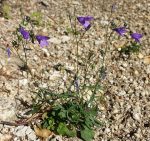 Also known as the bluebell of Scotland, harebell is a rhizomatous herbaceous perennial and a member of the Campanulaceae family that also includes ladybell (Adenophora), balloon flower, and Lobelia. It is almost circumboreal in distribution and found in many of the cooler regions of North America and Europe where it grows in dry, nutrient-poor grasslands , savannahs, prairies, and heaths, often in rock crevices, cliff faces, and dunes. Plants form a basal rosette of 1″ wide rounded toothed leaves on long petioles but these leaves often disappear before the flowers bloom. Several unbranched wiry flowering stems arise from each rosette bearing 2-3″ long grass-like leaves and carrying terminal flowers singly or in clusters throughout the summer. The bell-shaped flowers are nodding, blue, and 1/2 to 1″ wide. Harebell does best in cool climates and is a good choice for a rock garden or edges of a woodland garden. The genus name, Campanula, comes from the late Latin word, compana, meaning bell and refers to the form of the flowers. The specific epithet, rotundifolia, comes from the Latin words rotundatus, meaning round, and folia meaning leaf, and refers to the shape of the leaves.
Also known as the bluebell of Scotland, harebell is a rhizomatous herbaceous perennial and a member of the Campanulaceae family that also includes ladybell (Adenophora), balloon flower, and Lobelia. It is almost circumboreal in distribution and found in many of the cooler regions of North America and Europe where it grows in dry, nutrient-poor grasslands , savannahs, prairies, and heaths, often in rock crevices, cliff faces, and dunes. Plants form a basal rosette of 1″ wide rounded toothed leaves on long petioles but these leaves often disappear before the flowers bloom. Several unbranched wiry flowering stems arise from each rosette bearing 2-3″ long grass-like leaves and carrying terminal flowers singly or in clusters throughout the summer. The bell-shaped flowers are nodding, blue, and 1/2 to 1″ wide. Harebell does best in cool climates and is a good choice for a rock garden or edges of a woodland garden. The genus name, Campanula, comes from the late Latin word, compana, meaning bell and refers to the form of the flowers. The specific epithet, rotundifolia, comes from the Latin words rotundatus, meaning round, and folia meaning leaf, and refers to the shape of the leaves.
Type: Herbaceous perennial
Bloom: Bell-shaped, nodding, blue, flowers 1/2 to 1″ wide in summer
Size: 6-12″ H x 12″ W
Light:Full sun; tolerates some shade
Soil:Average, consistently moist, well-drained but drought tolerant once established.
Hardiness: Zones 2-7
Care: Divide every 3-4 years
Pests and Diseases: Slugs and snails
Propagation: Seed, basal cuttings, division
Companion Plants: Ozark bluestar (Amsonia illustri), Artemsia ‘Powis Castle’, butterfly weed ( Asclepia tuberosa), Mexican daisy (Erigeron karvinskianus), sneezeweed (Helenium autumnale), smallhead gayfeather (Liatris microcephala(, wild bergamot (Monarda fistulosa)
Outstanding Selections:
var. alba (creamy white flowers)
‘Flore-plena’ (double blue flowers)
‘Olympia’ (large, bright blue flowers)
var. soldanelliflora (semi-double blue, split flowers)
Photo Credit: Stefan.lefnaer, Wikimedia Commons